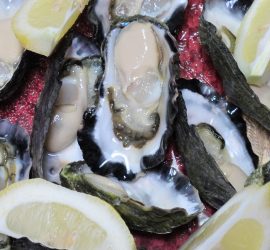Pacific Salmon

Ocean run salmon return to freshwater rivers and streams to spawn, but unlike the Atlantic salmon, Pacific salmon make their spawning run only once, dying shortly afterwards. There are five species of Pacific salmon. The Chinook or King salmon is considered the biggest prize, and is Alaska’s official State fish. Chinook are the biggest salmon, with some weighing over 80 kilograms. It is also regarded as the most delicious because it has the highest fat content, high in omega-3 fatty acid, and the richest flavour. Copper River and Yukon River Salmon are the most highly regarded of all Chinook, as they have the highest fat content, necessary for them to travel along the longest upstream migrations. Copper River salmon are particularly popular as they are the first Chinook to appear every spring, the first salmon of the season. The other favourite with sports fishermen is the Coho or silver salmon, a spectacular fighting fish that leaps out of the water energetically when hooked. Chum salmon are very similar in appearance to Chinook, but do not grow to the same size, typically weighing around 5-10 pounds. Chum or ‘Dog’ salmon are more widespread than the other Pacific salmon species, ranging from the Sacramento River in California to the Mackenzie River in Canada, and from Siberia to the southern Kyūshū island of Japan. Pink salmon are the smallest of the species, growing to a weight of around five pounds, and are very important to commercial and sport fishing. They are by far the most numerous salmon, and do not migrate as far upstream. Sockeye salmon are an important commercial species but are not pursued by sport fishermen, as they do not take lures or bait while on their spawning run. Male sockeye change their appearance spectacularly when spawning, turning a bright red colour, developing a very distinctive hump, and the long hooked jaws that are characteristic of spawning Pacific salmon. Many people prefer to eat sockeye due to their rich colour and milder flavour. There are landlocked sockeye native to some lakes of the Pacific Salmon that are known as kockanee.
King Crab

There are three kinds of Alaskan king crab caught commercially, the red, blue, and golden king crabs. The red king is considered the best, due to the fine quality of its sweet, succulent meat. As its name suggests, the crab has a dark, rich dark red colour before it is cooked, and white flesh with flashes of red here and there. By contrast, the blue crab is larger with a browner colouring, and the golden king smaller but more abundant than the others. Although an absolute treasure in its native Alaskan waters, the red king crab is considered by many to be a dangerous pest in Norwegian waters. It was introduced into the Berents sea in northern Russia in the 1960s, and has steadily spread south into Norwegian seas. Being a large crab reaching a size of up to 5 feet across, its ability to devour just about anything in its path presents a serious risk to the native ecosystem.
Halibut

Pacific halibut are the largest flatfish in the world, reaching an incredible size of 500 lbs (227 kilos), and a length exceeding 8 feet (2.5 metres) – no wonder the larger fish caught in Alaska are known as ‘barn door’ halibut. Halibut are also simply delicious to eat, with beautiful white chunks of firm meat that is perfect grilled, fried or boiled. They are caught at all depths, from very shallow to hundreds of metres, and are prize to both recreational and commercial fishermen for obvious reasons. They are readily caught with a wide range of baits, and by long-lining for commercial vessels. Due to their size and power, large fish are a real danger when caught so they are often shot before being brought aboard.
Halibut are a slow-maturing fish taking around 8 years to reach maturity, and this is why strict rules are placed on only taking fish above a length of 30 inches (76cm). While Atlantic halibut has been severely overfished, Pacific halibut in Alaska is a well managed fishery with stable stocks currently.

